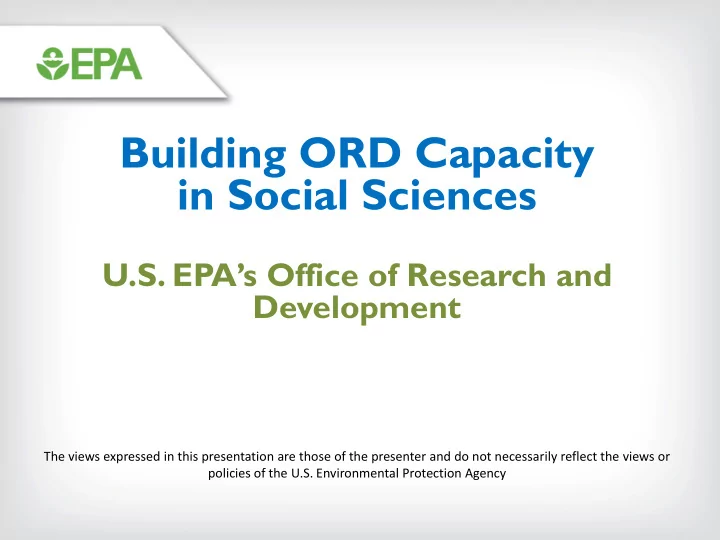

Building ORD Capacity in Social Sciences U.S. EPA’s Office of Research and Development The views expressed in this presentation are those of the presenter and do not necessarily reflect the views or policies of the U.S. Environmental Protection Agency
The Challenge • “Human systems are the primary drivers of the environmental challenges that the EPA is charged with managing.” – SAB, 2012 • Effective environmental regulations and policy must take into consideration human behavior – Context, interpretation, and perception matter • Decisions to protect human health and the environment should be based on the best available science – The best available science may stem from the natural sciences, the social sciences, or it may be interdisciplinary 2
Advice from the SAB/BOSC For years peer review panels have recommended ORD incorporate social science into research planning. T wo recent examples: SAB/BOSC 2012 - ORD should collaborate with other partners in the EPA…to develop a plan to develop the social, behavioral and decision science needed to support sustainability research and other goals identified in ORD’s six major research programs. A useful first step would be for ORD to plan a workshop on this topic and seek SAB and BOSC advice in workshop planning. SAB/BOSC 2015 - Explain how ORD will develop or access the social, economic and behavioral science needed to achieve the goals of the EPA’s Strategic Plan. 3
Other Advice • National Academy of Sciences (NAS) National Research Council (NRC) (2005) Decision Making for the Environment: Social and Behavioral Science Research Priorities – Including environmental decision processes, environmental considerations in business decisions, and environmentally significant decisions by individuals • Executive Order 13707 (September 15, 2015) Using Behavioral Science Insights To Better Serve the American People – To more fully realize the benefits of behavioral insights and deliver better results at a lower cost for the American people, the Federal Government should design its policies and programs to reflect our best understanding of how people engage with, participate in, use, and respond to those policies and programs. 4
Meeting the Challenge ORD is actively working to increase our social science capacity by: • Improving infrastructure • Developing key partnerships • Integrating social science principles into ORD’s research • Identifying resource needs ORD has developed a proposal to meet these challenges with specific actions to be taken in the: • Short-term (4 mos) • Medium-term (8 mos) • Longer-term (12 mos or more) timeframes. 5
Infrastructure • Goal: – For ORD to successfully incorporate social science expertise, models, and data as a regular part of our research • Actions: – Draft a social science vision statement for ORD – Identify key leaders in ORD and across the Agency who will be strong champions for ORD social science capacity – Designate a senior social scientist in ORD to coordinate initiatives across the organization, with other parts of EPA, and with the social science community – Strengthen EPA’s recently established Social Environmental Science Exchange (SESE) to enable facilitated dialogues – Expand the ACE Social Science T oolbox (an online knowledge repository in Sharepoint) 6
Partnerships • Goal: – For ORD to gain a better understanding of how to incorporate social-environmental science into our research planning • Actions: – Engage internal and external partners to: • Access available training and facilitation in the development of interdisciplinary research • Work across EPA to share experiences as we develop our own framework for realizing the benefits of interdisciplinary social- environmental science • Identify potential areas for research collaboration that could benefit from shared data, expertise, or resources – Expand EPA’s Social Environmental Science Exchange (SESE) 7
Integration of Social Science into ORD’s Research • Goal: – Expand and strengthen ORD’s consideration of social science methods and data in our research, as appropriate • Actions: – Cross-training of scientists • Hold workshops to provide insights into the value and practice of social science in research – September 22-23, 2016 –Wildfire Smoke and Health Risk Communication Workshop – October 4-5, 2016 – Workshop on the Integration of Social Sciences in Environmental Health Research – Evaluate opportunities where social science could enhance current projects – December 15, 2016 – Follow-up to ORD Workshop – Include social science experts in all stages of future strategic research planning 8
Identify Resource Needs • Immediate Resource Needs: – Designate a senior social scientist in ORD • Longer-term Resource Needs will be identified through a series of next steps to implement recommendations, including: – Identify gaps in expertise and develop a workforce hiring plan to fill key gaps – Identify FTE, $$ resource needs (by L/C/O) to implement hiring – Target post doc hires to work in the key areas identified 9
Bottom Line and Next Steps • The Bottom Line: – Social science is currently included in ORD research to a certain degree, but we need to: Expand and strengthen ORD’s consideration of social science insights in our research, as appropriate Build social science capacity and capability in ORD Increase interdisciplinary training to enhance communication and understanding between social scientists and those working in the natural sciences Goal setting and problem formulation must become an interdisciplinary activity Encourage and reward interdisciplinary research 10
Next Steps • December 2016 – ORD follow-up workshop and discussion of opportunities to integrate social sciences into planned research activities – Finalize ORD social science workshop report – Identify ORD senior social science lead • January 2017 – Meet with the BOSC to further discuss ORD’s social science activities • Spring and Summer 2017 – COSSA and American Sociological Association presentations – Begin using EPA’s SESE’s facilitated dialogue function to brainstorm proposed social science research activities 11
Recommend
More recommend